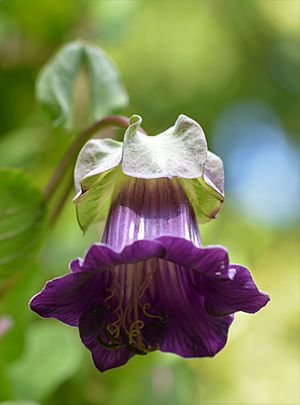Cup-and-saucer vine facts for kids
Quick facts for kids Cup-and-saucer vine |
|
|---|---|
 |
|
| Scientific classification | |
| Genus: |
Cobaea
|
| Species: |
scandens
|
Cobaea scandens, often called the cup-and-saucer vine or cathedral bells, is a beautiful climbing plant. It belongs to the phlox family, called Polemoniaceae. This plant originally comes from Mexico. You might also find it in some tropical parts of Central and South America.
What it Looks Like
This plant is a perennial climber, meaning it lives for more than two years and grows upwards. The name scandens actually means "climbing" in Latin!
Its leaves are about 4 in (10 cm) long. Each leaf has four smaller parts called leaflets. It also has a special part called a tendril. These tendrils have tiny hooks that help the plant cling to things as it grows.
The flowers are large and violet. They are shaped like bells and have a noticeable ruffle, which is why people call them "cup-and-saucer" flowers. In their natural home, bats help pollinate these flowers. When the flowers are fully grown, they smell nice. After flowering, the plant produces round fruits with seeds inside.
Growing This Plant
Many people grow Cobaea scandens because it climbs well and has very pretty flowers. The flowers are about 5 cm (2 in) long and change color from white to purple as they get older.
If you live in a place with a temperate climate (where it gets cold in winter), it's best to grow this plant as a half-hardy annual. This means you plant it each year. You should start the seeds indoors in early spring where it's warm. Then, plant them outside once there is no more danger of frost.
This plant is so popular that it has won an award! The Royal Horticultural Society gave it their Award of Garden Merit in 2017. There is also a white version of this plant, called C. scandens f. alba.
Charles Darwin's Studies
Charles Darwin, a famous scientist, studied many climbing plants in 1875. He watched how they moved and reacted to things like light and touch. He was very impressed by how strong and fast Cobaea scandens grew. He carefully observed its movements over time.
See also
 In Spanish: Yedra morada de México para niños
In Spanish: Yedra morada de México para niños


